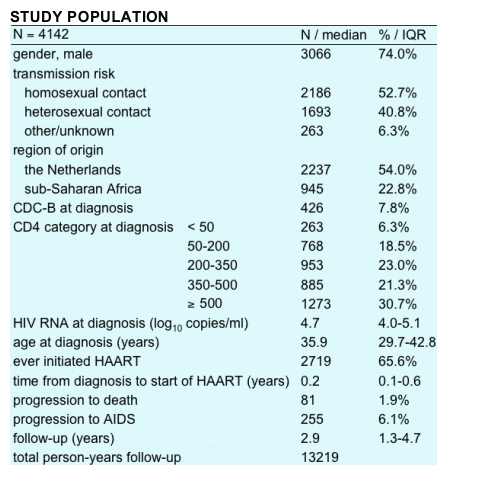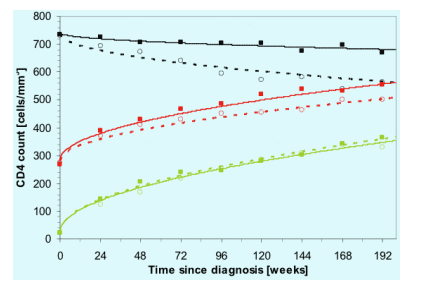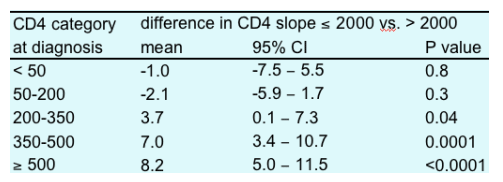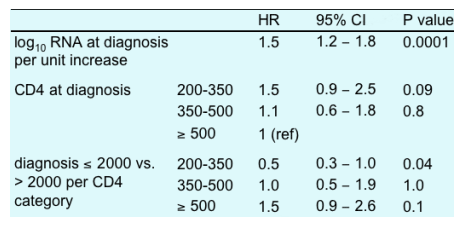 |
 |
 |
| |
A CD4 threshold below 350 cells/mm3 for initiation of HAART is associated with a higher risk of AIDS, ATHENA Cohort
|
| |
| |
Reported by Jules Levin
4th IAS Conference, July 2007, Sydney, Australia
Ard van Sighem1, Luuk Gras1, Colette Smit1, Anouk Kesselring1, Frank Kroon2, Kees Brinkman3, Joep Lange4, Frank de Wolf1
1 HIV Monitoring Foundation, Amsterdam, NL; 2Leiden University Medical Centre, Leiden, NL; 3Onze Lieve Vrouwe Gasthuis, Amsterdam, NL; 4Academic Medical Centre of the University of Amsterdam, Amsterdam, NL
Excerpt from NATAP Report regarding this study, from IAS on starting therapy earlier.
Mark Mascolini
That perennial question--when to start antiretroviral therapy--got plenty of play at the 4th IAS Conference on HIV Pathogenesis, Treatment, and Prevention in Sydney. Indeed, the issue arose enough to inspire some grumbling that the early-start faction had loaded the program. Or could it just be that more researchers want to know if stronger, safer regimens deserve an earlier try in people infected with a virus whose depredations (pillaging attack) begin on the first day of infection and get worse with time?
This article reviews six Sydney studies that address the question of when to begin antiretroviral therapy.
Do conservative start guidelines need updating?
Seven years ago the Netherlands retooled its antiretroviral guidelines to advise starting therapy at a CD4 count between 200 and 350 rather than between 350 and 500. At the Sydney meeting Dutch investigators offered evidence suggesting that change may no longer make sense [1].
This analysis by Ard van Sighem (HIV Monitoring Foundation, Amsterdam) involved 4142 ATHENA cohort members diagnosed with HIV between 1998 and 2005. All were at least 16 years old, and all either remained untreated or began a potent antiretroviral regimen during that time. No one had AIDS when they joined the cohort, and none got infected by injecting drugs. In one part of the study the Dutch team focused on 1422 people (34.3%) with at least 4 years of follow-up and stratified by CD4 count: under 50, 50 to 200, 200 to 350, 350 to 500, and above 500. They figured progression to earliest AIDS diagnosis or death in 3111 people (75.1%) with more than 200 CD4s when diagnosed with HIV.
In the whole 4142-person group, 74% were men. While 52.7% got HIV during sex between men, 40.6% got infected heterosexually and the rest by other or unknown routes. Just over half of the cohort was born in the Netherlands, and 22.8% came from sub-Saharan Africa. While 6.3% entered ATHENA with fewer than 50 CD4 cells, 18.5% had 50 to 200, 23.0% had 200 to 350, 21.3% had 350 to 500, and 30.7% had more than 500. Viral load at diagnosis ranged from about 10,000 to 100,000 copies. Almost two thirds of the cohort (65.6%) started antiretrovirals at some point during follow-up.
During 1.3 to 4.7 years of follow-up, 81 people (1.9%) died and 255 (6.1%) got an AIDS diagnosis. CD4 counts at diagnosis proved higher in people diagnosed before 2000 than in those diagnosed later. For people with 200 to 350 CD4s, 350 to 500 CD4s, or more than 500 CD4s at diagnosis, counts rose significantly more slowly in those diagnosed after 2000--that is, after the guideline changes--than in those diagnosed before 2000 (Table 1).
In the group with at least 200 CD4 cells at HIV diagnosis, 45 died, 135 wound up AIDS, and 165 got AIDS or died. In an analysis statistically adjusted for age, entry CDC disease status, gender, and region of origin, every log unit higher viral load at cohort entry raised the progression risk 50% (95% confidence interval [CI] 1.2 to 1.8, P = 0.0001).
A CD4 count between 200 and 350 at HIV diagnosis compared with more than 500 also boosted progression risk by 50% (HR 1.5), but that correlation fell just short of statistical significance (95% CI 0.9 to 2.5, P = 0.09). Progression risk varied hardly at all between people who entered the cohort with 350 to 500 CD4s and those who entered with more than 500 CD4s. When van Sighem figured progression risk in people diagnosed before versus after 2000, diagnosis with 200 to 350 cells in or before 2000 halved progression risk (HR 0.5, 95% CI 0.3 to 1.0, P = 0.04).
NATAP asked van Sighem why the overall worse prognosis with a CD4 count between 200 and 350 turned in the other direction in people diagnosed before 2000. The year-2000 change in Dutch guidelines probably explains this finding, he suggested via e-mail. Because of the guideline change, people with 200 to 350 CD4s were more likely to start combination therapy if diagnosed before 2000 than after 2000.
The hazard ratio of 0.5 in people diagnosed before 2000, van Sighem amplified, "shows that there is some disadvantage in being diagnosed after 2000, and we suppose that this is due to the delayed start of combination antiretroviral therapy after 2000. We argue that as antiretroviral drugs are becoming less toxic, combination antiretroviral therapy might be started at higher CD4 cell counts than currently recommended."
Author Conclusions & discussion
CD4 counts after diagnosis are higher in patients diagnosed in or before 2000 compared to those diagnosed thereafter.
Patients with CD4 counts 200-350 have a slightly higher risk of disease progression when diagnosed after 2000.
As current HAART regimens are less toxic and easier to adhere to than before 2000, the CD4 threshold for starting HAART should be reconsidered
Background
The optimal time to start HAART is still subject to debate. In 2000, the CD4 cell count range below which HAART should be started, according to guidelines in the Netherlands, was lowered from 350-500 to 200-350 cells/mm3. We analysed changes in CD4 cell counts and progression to AIDS and/or death after HIV diagnosis, comparing patients diagnosed before and after 2000.
Methods
4142 patients were selected from the ATENA national observational cohort who
--had an HIV-1 diagnosis between 1998 and 2005.
--were 16 years of age or older at diagnosis and were not infected through intravenous drug use.
--did not have a concurrent AIDS diagnosis.
--were either untreated during follow-up or started HAART whilst being
antiretroviral therapy na•ve.
CD4 counts at diagnosis were categorised in < 50, 50-200, 200-350, 350-500, and ≥ 500 cells/mm3.
A mixed effects model with random intercept and slope and an autoregressive covariance structure for measurements within the same patient was used to analyse longitudinal data on CD4 counts after diagnosis in 1422 (34.3%) patients with at least 4 years of follow-up, stratified according to CD4 counts at diagnosis and according to diagnosis in or before 2000 or thereafter.
Progression to the earliest of AIDS or death was studied in 3111 (75.1%) patients with ≥ 200 cells/mm3 at diagnosis using Cox' proportional hazard model adjusting for age, CDC status, gender, and region of origin.
"Intention-to-treat" analyses were performed, assuming that HAART was started according to the guidelines.
HAART was started according to the guidelines.

There was no difference in the distribution of CD4 counts in patients diagnosed in or before 2000 or thereafter in the 1422 patients with at least 4 years of follow-up.
Changes in CD4 counts over time
The plot shows data and predictions of the mixed effects model for patients diagnosed in or before 2000 (data: squares; prediction: solid lines) or thereafter (data: circles; prediction: dashed lines) with CD4 < 50, 200-350, or >500.

Compared to patients diagnosed in or before 2000, CD4 counts in patients diagnosed after 2000 decreased faster or increased slower for patients with CD4 counts at diagnosis >200 cells/mm3.

Progression to AIDS and/or death
Of the 3111 patients with ≥ 200 cells/mm3 at diagnosis, 45 died, 135 progressed to AIDS, and 165 progressed to AIDS/death.
Hazard ratios (HR) associated with progression:

--log10 RNA was the most important predictor of progression.
--Patients with CD4 counts 200-350 tended to have a lower risk of AIDS/death when diagnosed in or before 2000 than thereafter.
|
| |
|
 |
 |
|
|